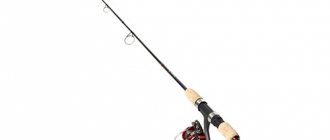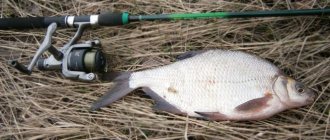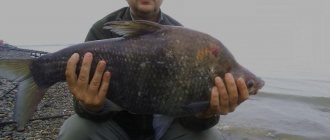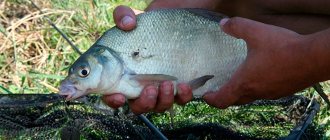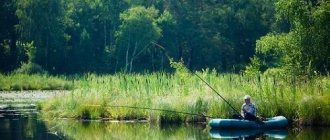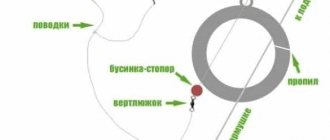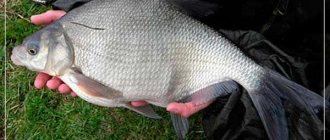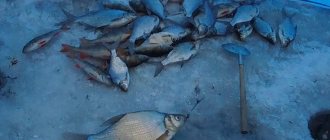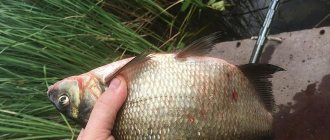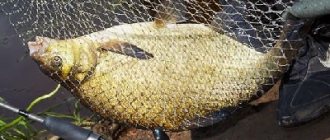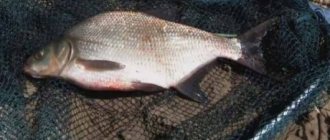Many anglers react with surprise to the fact that some peaceful fish are caught on artificial baits. Fishing for bream with a spinning rod can be done purposefully, and not become a passing catch when hunting for a predator. Most often, fish turn purple when a spoon or wobbler gets into a school of bream. But if you assemble your spinning rod correctly and select special baits, you can expect a classic bite.
Why is bream caught on spinning baits?
Many species of fish that lead a peaceful lifestyle in their youth, having reached large sizes, begin to feed on fry. Bream is no exception, although most anglers find it hard to believe. After all, after opening the abdominal cavity, no fragments of small fish are found in the stomach. The fact is that before swallowing food, the bream carefully grinds it with its pharyngeal teeth. Therefore, a kind of porridge from ground fish meat already ends up in the stomach.
Bream does not always hunt for small things; it feeds most actively on live fish during the period when the fry is growing.
Depending on water temperature and region, the bite may begin in June or July. This is interesting!
Fans of spinning bream fishing have noticed that artificial baits catch only healthy specimens without parasites. Although in the same area of the reservoir, individuals infected with the Ligulidae are also caught on a feeder or float. Thus, we can definitely say that targeted fishing for bream using spinning tackle can bring good results.
Equipment of a spinning rod for catching bream with a spinning rod
To catch bream, we will use a light or ultralight spinning rod. Ultralight models must withstand powerful jerks. These rods are designed for fishing for bass, trout and large perch.
The rod should be light. If you are not an experienced spinning angler, then it will be difficult for you to work with a heavy rod throughout your fishing trip. With the help of a spinning rod, all the nuances of wiring and feeling the bait are important.
Naturally, the test of the rod should correspond to the weight of the bait. In our case, we will use spinning rods with a top dough of up to 16 grams. The length of the rod is selected depending on the fishing distance. The optimal length can be considered 2.7 meters.
Which spinning company to choose is up to you to decide. We will not name specific models, since there are a large number of them. But one thing is for sure. You can choose a spinning rod from among inexpensive models. To catch bream, you don’t need any special gear or fishing technique.
It’s even easier to choose a spinning reel. There are no special requirements for her. It is enough to find a model with a spool size of 3000 with a front drag. The main thing is that it moves smoothly and winds the braided cords evenly. Most manufacturers make reels adapted to work with thin cords.
It is advisable to use a round cord with a thickness of 0.12 m. It can consist of 4.8 or more strands that are tightly intertwined. These lines are designed for jig fishing.
The cord should be smooth and not rub against the rings. It is better to use bright braids that are easy to notice when fishing near vegetation. The breaking load of the braids should be 4-5 lb. Bream, as you know, does not offer such fierce resistance as pike. Therefore, you should not chase too strong braids.
Are leashes necessary when fishing for bream using a spinning rod? Definitely no. When fishing for pike, they use leashes. Bream is not able to cut the line.
Selection of tackle and bait
Local fishermen catch bream using powerful spinning rods that remain from the times of the Soviet Union. But it is much more interesting to fish with an elegant light fishing rod. It consists of the following components.
- The rod selected is carbon fiber from the light or ultralight series. The test load should correspond to the baits that will be used for fishing. The length of the rod should be small, 2.1-2.4 m; with such a “stick” it is more convenient to control the bait. Good spinning rods are made by Pontoon 21 and St. Croix.
- A spinning reel requires lightness, precise operation of the clutch, and high-quality line laying. Therefore, it is better to pay attention to products from Shimano or Daiwa with a spool size of up to 2500.
- It is best to equip a spinning fishing rod with a braided cord, which is soft and smooth. It should be quite rigid and as round as possible. The thread should have a breaking load of 4 to 8 lb. High-quality braid is manufactured by Sunline and Daiwa.
- When there is a high probability of a pike biting, it is better to use a fluorocarbon leash with a diameter of 0.16...0.18 mm. Seaguar leashes performed well.
When choosing bait, you need to find out which fry lives in the river or pond. Then it will be easier to find a natural imitation of the food item.
- The most popular artificial bait for bream are silicone fish. They give high results at an affordable price. Of particular interest to fish is edible rubber, which is impregnated with special attractants. As for shape, narrow-bodied fish or small worms work best.
Recommendation! In order for ordinary silicone baits to acquire a certain smell, fishermen keep them in plastic bags with flavorings. Bream like the taste of shrimp, garlic and anise.
High-quality edible baits are made by Kota, Rein's and Megabass. You need to experiment with the coloring of the rubber; at a certain moment, a bait with a natural tint may work. Sometimes fish like fancy colors. It is best to mount silicone fish using a swivel joint.
- Among the spinners, we can distinguish spinners with a narrow blade and small size No. 00-2 according to the Mepps classification. The vibrators should have a similar size.
Jigs for bream on board fishing rods in summer
My homemade jigs for catching bream in summer on river currents with side rods are shown in the photo. Those who want to evaluate homemade jigs for bream of other shapes can click on the photo.
All jigs shown are made of lead and are intended for catching bream and other fish from the shore with a long rod or a side rod from a boat on river currents of varying intensity.
Strong currents are observed in rivers with steep banks during spring floods and when fishing in the summer after heavy rains. Heavy lead homemade jigs are suitable for catching bream and other fish of the carp family rising against the current with side rods.
In the left position of the photo are homemade jigs for bream with crowns made of non-ferrous metals soldered over lead bodies, which are best used for catching bream in the summer not in the current, but in closed reservoirs at great depths. When finishing, I limited myself to the process of dull grinding the surfaces of the baits.
The bottom of the bodies of all homemade jigs intended for summer bream fishing, both in enclosed reservoirs and in the current with side fishing rods, are painted with dark tones of paint: green, brown, black and their shades.
In the right half of the photo there are lead jigs, mostly used in fishing for catching bream in the summer from a boat with side rods on fast river currents.
Summer tin-lead jigs for bream
My jigs for catching bream with side rods in rivers that are not very clean, with soft, eroded soils are shown in the photo. These are homemade tin-lead jigs with polished crowns.
Homemade baits are made with your own hands from tin-lead solders of different brands (POS18 - PROS90), designed for catching bream during summer fishing in not very clean waters of a lake or river.
The weight of the jig is selected according to the strength of the current, the depth of bream fishing and the thickness of the fishing line on the summer fishing rod.
Lead jigs for side fishing rods for bream
For catching bream with side rods in rivers with hard bottom soils, in my opinion, lead jigs painted in dull dark colors are better suited.
The following requirements apply to jigs for catching bream in the summer on the river with short side rods from a boat:
1. The rear end of the jig tied to the line of the onboard fishing rod must be streamlined, otherwise the bait begins to be dragged excessively and raised high above the bottom under the side of the boat.
2. The angle of inclination of the jig for catching bream in summer with a side fishing rod on the river flow should be within 30-45 degrees. To do this, the hole for winding the fishing line relative to the center of gravity of the bait is shifted to the rear of the jig.
3. The jig of a side fishing rod for catching bream in summer should hold the river flow well. When the bait is carried far from the boat, it may not fall into the stream of food being washed away from the feeder, or the bream may even end up between the jig and the feeder.
Choosing a fishing spot
To hope for success in spinning fishing, it is important to find places where bream congregate. Only with high competition will the fish confidently attack a passing bait.
- Bream prefers to stay in areas of the reservoir with a rocky or pebble bottom. The flock can also linger on the shell rock. The depth at the fishing point can vary from 1 to 8 m. The presence of a current is very important for a good bite; only small bream can be caught in still water.
- Schools of fish like to stand on sandy, muddy and clay bottoms, but bream rarely feeds in such places. Most often, fish simply rest in such water areas.
- Large bream are best attracted by a combination of large stones, shell deposits and aquatic vegetation. And in the summer heat, areas of a reservoir with underwater springs or flowing streams become promising for fishing. The flock takes a position on the border of warm and cold water, where it picks up food.
- Water areas with large obstacles are successful for fishing. This could be an accumulation of boulders or snags that slow down the flow of the river. Below the obstacle, a hole is formed, at the bottom of which branches, shells and stones accumulate. Towards the end of summer there is an overgrowth of mud or thread-like vegetation. Insects and worms hide in it, attracting bream.
Catching bream with spinning baits
Most anglers who have ever caught bream will answer that this fish is caught with a bottom, feeder or float rod. However, modern realities are such that bream, like any other peaceful fish, is quite possible to catch with a spinning rod. Today, catching bream with spinning baits,
primarily on jigs, it is becoming increasingly widespread.
Therefore, this article will focus specifically on catching bream using a spinning rod. Place for fishing
Before you start fishing, you need to choose a place where this fish will be caught. The same applies to bream fishing. Due to its lifestyle, bream prefers to stay on shell and rocky areas of the bottom. Moreover, it can live at different depths, for example, 4-10 m, or 1.5-2 m. A very important condition is the presence of at least a weak current in the habitats of this fish. Where there is no current, you will rarely see bream. Even depth is not so important for a comfortable habitat for bream. Often, anglers caught bream weighing from 1 to 2.5 kg, in places where the depths did not exceed 1 m, and sometimes less.
Catching large bream
possible on sandy-silt or clay bottom sediments. However, in such places the bream mainly spends its resting time, and it feeds there extremely rarely. Active feeding of bream usually occurs in areas with a rocky bottom. And if among the bottom boulders there are colonies of barley shells or dreisena, then the fisherman is very lucky and the bream catch there will be very significant.
Another significant factor that influences the absence or presence of bream is the constant influx of fresh water, as from the banks in the form of streams or springs, but the influx must also be present on the bottom topography. Large bream primarily love these areas. This is especially important during the summer heat, because at such times the water temperature often reaches 25-26 0C. It can be noted that areas where there are similar outlets of cold springs are something similar to a feeding table for bream.
Very promising fishing for bream with a spinning rod
occurs in areas where there are any large obstacles impeding the flow, for example, a boom made of tree branches or stones, it sharply slows down the flow and leads to the washing out of the hole behind it. At the bottom of such local depressions there are many different logs and branches, large stones and settled shells. Such places are always very attractive for bream. By the end of July, in the central regions of Russia, thread-like algae grows abundantly in reservoirs; fishermen usually call them mud. It abundantly covers stones, bridge piles, branches, and creates long lashes. They perfectly protect the water column from bright sunlight. They also contain a huge number of different worms and insects, which are excellent food for fish. If in the process of searching for bream places you come across at least one place similar in description, you can say with confidence that there is bream there somewhere nearby.
Tackle for catching bream
All the places and conditions described above require appropriate gear. The most suitable tackle for such conditions is considered to be kid or ultralight spinning tackle. It should be noted that ultralight class tackle has a fairly large deterrent resource. They are designed to withstand strong fish such as brook trout or bass.
As a rule, special requirements are imposed on such fishing rods:
· The lightness of an ultralight rod, the sensitivity of the wiring and the load on the angler depend on it. It is very difficult to hold a heavy and rough rod for several hours in a row. In addition, such a rod senses the play of the bait very poorly, which does not allow it to respond to bites in a timely manner.
· Short length of the spinning rod, which allows you to control the wiring and change its modes mobilely.
· The test corresponds to the bait; exceeding it will not allow you to fully experience the pleasure that comes from catching fish.
· A good rod should seem to stick to the fish, it should not allow it to break due to a break in the thin line or a tear in the lip.
These requirements today are met by modern carbon fiber rods, which fit well in the hand and meet the requirements listed above. In this case, catching bream with ultralight
, will give the fisherman the most unforgettable experience.
Today, such series as KGLights from Major, Daiko, Finezza, Pontoon 21, and others are popular among ultralight lovers. For bream fishing, spinning rods from the Encore Nemesis series are considered very promising. As for reels, there is no strict standard. However, you should not get carried away with budget series. The reel should be light, have a smooth ride, reliable friction and precise placement. Nowadays, thin braided cords place their own demands on reels. Experienced fishermen who know a lot about ultralight tackle recommend equipping an ultralight spinning rod with Shimano, Daiwa or Pflueger reels.
Successful catching of bream using ultralight baits
largely depends on the cord. Such a cord should be thin, smooth and as round as possible, and the main thing is not to make noise on the rings. In a word, the most common requirements for cords used in microjig fishing. These requirements are fully met by Japanese cords from manufacturers such as Varivas, Daiwa or Sunline. How the color is shown does not matter.
Is it necessary to put a metal leash on the ultralight? For ultralight, such a leash is not needed; if in the fishing areas there is a chance that a pike will bite, it is better to put a fluorocarbon leash with a diameter of 0.15-0.17 mm. This action allows you to increase the frequency of bites from larger fish, especially when they are not very active.
Lures for bream
The most promising bream fishing with silicone baits
. Their popularity is growing every year. This is explained by high efficiency and relatively low price. Almost every spinning angler knows about them and has used them at least a couple of times while fishing.
“Edible rubber” is especially popular. This is ordinary silicone, packaged in bags with special additives and impregnated with various attractants. From a very diverse assortment of silicone having a variety of sizes and shapes, small narrow-bodied baits and worm-shaped baits should be highlighted.
A variety of slugs, especially light shades or white, give very good results. As for the taste preferences of bream, this fish is most often attracted to baits that smell like fried garlic, shrimp or anise. Sometimes the fish bite very actively on the bait, which, to the human eye, has a rather disgusting smell.
The leader in the production of various flavors today is the Kota company. Peaceful fish especially like lures from the Leech series. Silicone baits should have a soft body and be shaped like bottom organisms.
Happy fishing!

